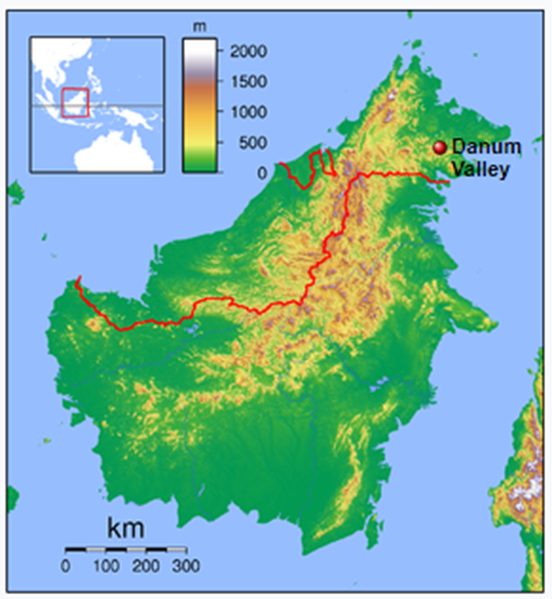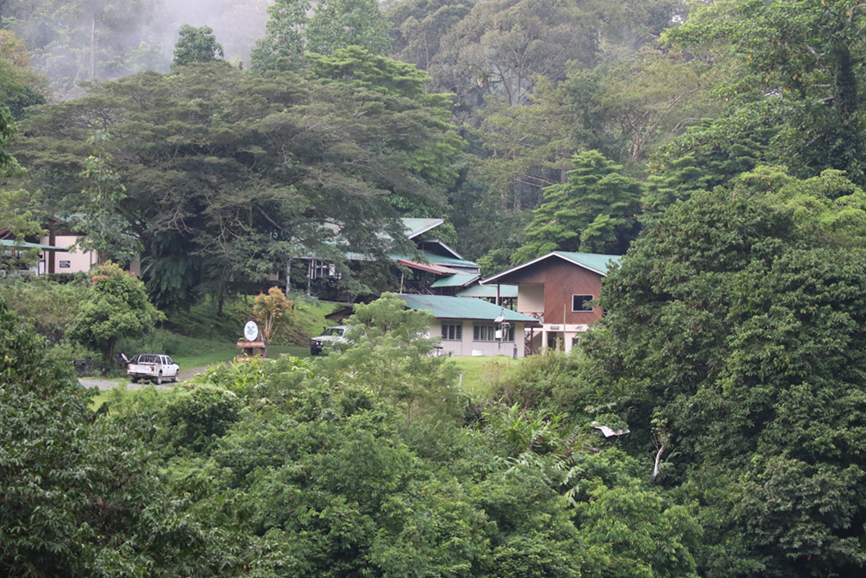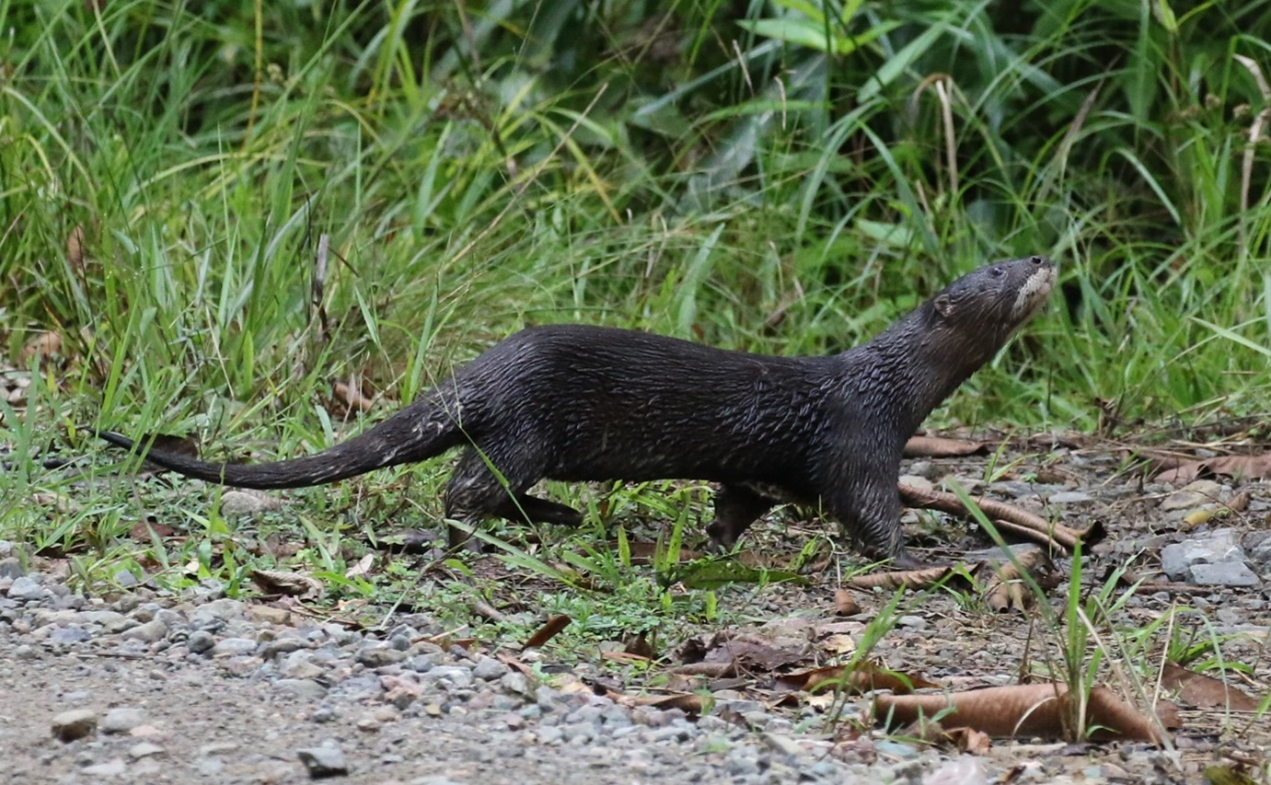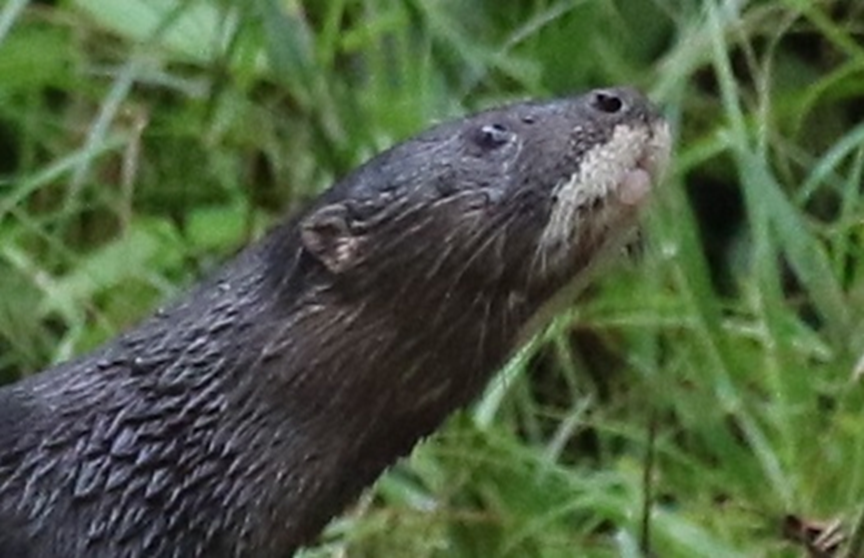IUCN/SSC Otter Specialist Group Bulletin

©IUCN/SCC Otter Specialist Group
Volume 37 Issue 3 (November 2020)
Citation: Pain, D ((2020). A Review of the Hairy-Nosed Otter (Lutra sumatrana) in Borneo and a Recent Sighting at Danum Valley Conservation Area, Sabah. IUCN Otter Spec. Group Bull. 37 (3): 171- 178
A Review of the Hairy-Nosed Otter (Lutra sumatrana) in Borneo and a Recent Sighting at Danum Valley Conservation Area, Sabah
Deborah Pain1
School of Biological Sciences, University of East Anglia, Norwich Research Park, Norwich NR4 7TJ, UK; Department of Zoology, David Attenborough Building, University of Cambridge, Pembroke St, Cambridge CB2, UK. e-mail: pain596@cam.ac.uk; pain.debbie@gmail.com pain.debbie@gmail.com

(Received 11th January 2020, accepted 9th May 2020)
Abstract: The Hairy-nosed Otter Lutra sumatrana is one of the rarest and least well known of the world’s Otters. The species was seen and photographed in close proximity to Danum Valley Field Centre, Sabah, in October 2019. The Danum Valley Conservation Area comprises protected lowland dipterocarp forest and may be the only place currently known to host all four Southeast Asian Otter species. In this paper I describe the sighting, summarise other recent (post 2000) Hairy-nosed Otter records in Borneo and briefly discuss the status and conservation of the species.Keywords: ELutra sumatrana, Danum Valley Conservation Area, Sabah
DISTRIBUTION AND RECENT SIGHTINGS OF THE HAIRY-NOSED OTTER
The Hairy-nosed Otter Lutra sumatrana is endemic to Southeast Asia and is one of four otter species found in the region including the Eurasian Otter Lutra lutra, Smooth-coated Otter Lutrogale perspicillata and Oriental Small-clawed Otter Aonyx cinereus. According to Wright et al. (2008) the species appears to have been generally considered common until the middle of the twentieth century, but by 1977, when it was listed on CITES Appendix II, the Hairy-nosed Otter was thought to be declining. There was concern over its status as no records had been reported for a decade or more until an animal was seen in southern Thailand in 1999 (Kanchanasaka et al., 2003 reported in Wright et al., 2008). A new specimen was also collected in Brunei in 1997 (Sasaki et al., 2009). Since the late 1990s it has been rediscovered in several places, with a small number of observations from scattered localities in Thailand, Indonesia, Vietnam, Cambodia, and Malaysia (e.g. Wright et al., 2008; Baker, 2013; Latifiana and Pickles 2013; Salashour, 2016, see also references in Aadrean, 2015 and Table 1) and a skin found in trade in Myanmar (Shepherd and Nijman, 2014). It has been studied in several locations including Phru Toa Daeng Peat Swamp Forest in Thailand (Kanchanasaka and Duplaix, 2011), U Minh Thuong Nature Reserve in Vietnam (Nguyen et al., 2001) and Tonle Sap in Cambodia (Poole, 2003; Heng et al., 2007; Wilcox et al., 2016) but neither group sizes nor abundance are known (Aadrean, 2015). The paucity of records and studies of this species do not allow for a complete description of its habitats and altitudinal range. However, it has been reported in flooded forest, peat swamp forests, lowland dipterocarp forest, freshwater swamp forest, and estuaries dominated by Nypa and mangroves (IUCN Otter Specialist Group, 2015). Insufficient information is available to estimate population size or the number of mature animals and only limited and fragmented information exists about the full extent of the species' historical geographic range. It remains poorly known and is the rarest of Asia’s otter species, listed as Endangered by IUCN (Aadrean et al., 2015) with a decreasing population.
Wright et al. (2008) identified that the island of Borneo should be surveyed wherever possible as it formed part of the species’ historic range. Subsequently, there have been a handful of confirmed records from the island (Table 1) including from Kalimantan (Huda et al., 2019) and Sabah, where the species has been reported from three locations; the Kinabatangan River (Hobcroft, 2009), Deramakot (Wilting et al., 2010) and the Lower Segama area (Ishigami et al., 2017). Until their recent study (Table 1) Huda et al. (2019) reported that, as of mid-2019, there had been no records of this species in the southern part of Borneo, south of the 01°15'00.00"S line. Sasaki et al. (2009) surveyed Hairy-nosed Otter specimens lodged in a range of museums around the world and reported 12 from Borneo, of which two are historical specimens from Sabah state (1876 and 1880), four from Sarawak, four from Brunei, and two from Kalimantan. The most recent specimens appear to have been from Brunei (1978, 1986 and 1997), although there do not appear to be subsequent records from there.
SIGHTING OF HAIRY-NOSED OTTER NEAR DANUM VALLEY FIELD CENTRE IN DANUM VALLEY CONSERVATION AREA
In October 2019, I undertook a mammal and bird watching holiday to Sabah, Borneo, including a visit to Danum Valley Field Centre (Fig. 1,2; 4.9647°N, 117.8051°E), a scientific station located on the edge of the 43,800 ha Danum Valley Conservation Area (DVCA). DVCA is a Class I (Protection) Forest Reserve containing the largest remaining area of undisturbed lowland dipterocarp forest in Sabah. It is located in Southeast Sabah, on the western side of the upper reaches of the Segama River (http //www.borneoforestheritage.org.my/Danum/location.htm).

Credit. Sadalmelik – Own Work. https://commons.wikimedia.org/wiki/User:Sadalmelik. Topographic locator map of Borneo. Created with GMT from public domain SRTM data. For non-locator version, see Image:Borneo Topography.png. Left:108 Bottom:-5 Right:120 Top:8 https://creativecommons.org/licenses/by-sa/3.0/. File:Borneo Locator Topography.png. Created: 1 September 2007.
On 12 October 2019 at 3:30 pm, while walking along the entrance track away from Danum Valley Field Centre (DVFC, Fig 2), approximately 1 km from the centre I saw and photographed an otter crossing the track. Just before a left hand bend, a small stream runs under the road, and an otter appeared from the left hand side of the culvert, crossed the road, stopped briefly, and then disappeared back into the vegetation next to the stream on the other side of the road. I am very familiar with Eurasian Otter but the animal I saw was distinctly different to Eurasian Otter, although broadly similar in size. My initial impression of the otter was that it had a dark pelage and a very distinct and clearly demarcated white chin. On subsequent examination of my photographs, the literature, and consultation with otter experts, the species was identified as Hairy-nosed Otter. This rare species is poorly known, but distinct physically and genetically from its sister species, the Eurasian Otter, from which it is reciprocally monophyletic[1] (Koepfli et al., 2008).
The features that distinguish Hairy-nosed from Eurasian Otter in the field all appeared to be present in the animal observed (Fig. 3). The animal had a darker brown pelage than Eurasian Otter, with the ventral and dorsal surfaces appearing to be the same colour. It had a very distinctive white upper lip, chin and front part of the throat that did not extend down the breast. The enlarged photos (Fig. 4 ) show a naked rhinarium as a circle around the nostril (whereas Eurasian Otter does not have this) and no greyish fur on the cheeks (as is found in Eurasian Otter) (N. Duplaix, pers. comm. for comments on these identification features). Hairy-nosed Otter is also described as very long and snaky in shape, with a long and slender tail (Wright et al. 2008), and this was consistent with my impression of the animal, and the photographs.
Wright et al. (2008) reported that Sasaki (pers. comm. cited in Wright et al., 2008) compared the skull measurements of the four species of otters found in Asia and found that those of Hairy-nosed and Eurasian Otters were very similar, and distinct from Smooth-coated and Oriental Small-clawed Otters. While detailed measurements found a more elongated skull and rounder braincase in Hairy-nosed Otter, skull shape is considered to be of limited use for distinguishing between Hairy-nosed and Eurasian Otters in the field (Wright et al., 2008), although it may be a useful feature from certain angles with a good close view (e.g. see Figure 5 in Ishigami et al., 2017).
This appears to be the first published record this century of Hairy-nosed Otter from the Danum Valley area although the species has previously been included in a species list for the site (Emmons 2000). Camera trap photos from Danum Valley in 2013 show a mystery animal that may possibly have been either Hairy-nosed or Eurasian Otter, but the photos were not sufficiently clear for a firm identification (https://www.mammalwatching.com/2013/03/26/mystery-beast-danum-valley-borneo/). BirdLife International (2020) in their site description of DVCA note the occurrence of Hairy-nosed Otter, but the site description was from 2007 (Yeap et al. 2007 - the species was listed by IUCN as Data Deficient at the time) and the origin and date of the DVCA record is not obvious. All four Southeast Asian Otter species occur on a checklist of the mammals of Danum Valley (https://www.sunda-islands.com/files/tieredanumvalley.pdf), although no information is readily available concerning the date or origin of the information on this list.
The closest records to DVCA of Hairy-nosed Otter are from Deramakot Forest Reserve (Table 1), approximately 20km away. While DVCA comprises 43,800 ha of protected and undisturbed lowland dipterocarp forest, the adjacent Deramakot Forest Reserve comprises 55,507 hectares of commercially logged mixed dipterocarp forest that was logged at least once before the commencement of the current management project, set up to demonstrate good forest management practices (http://www.deramakot.sabah.gov.my/). At Deramakot, 49,711 ha has been set aside for log production, 5,778 ha for conservation and the remaining 18 ha for community forestry. Recent records of Hairy-nosed Otter from these two forest sites highlight their importance for the conservation of this rare and threatened species, and of the value of maintaining some level of connectivity between them.
In their camera trap study at Deramakot Forest Reserve, Wilting et al. (2010) recorded Oriental Small-clawed Otter, Smooth-coated Otter and Hairy-nosed Otter, with records within a 250 ha area. In July 2014, Jon Johnston (Humbolt California State University) photographed a pair of Eurasian Otters near DVFC (Segama river) (Phillipps and Phillipps, 2018). The current record of Hairy-nosed Otter provides recent photographic evidence of the species at Danum which may be the only, or one of only a few places where all four Southeast Asian otter species are currently known to coexist. Additional field data are required to see if this situation occurs over a larger part of the region.
THE STATUS OF HAIRY-NOSED OTTER AND ITS CONSERVATION
In 2014 IUCN reclassified the rare and declining Hairy-nosed Otter from Data Deficient to Endangered. Increased searching intensity since the beginning of the century has resulted in additional records of Hairy-nosed Otter, from habitat types including undisturbed lowland dipterocarp forest, commercially logged lowland forest areas, peat swamp forests and mangrove and peat swamp in an area of lowland dry dipterocarp and oil palm. The species was also historically reported up to an altitude of 1,200 meters asl in Pa Umur in the Kelabit highlands, Sarawak (Davis, 1958, cited in Huda 2019). However, despite increased searching intensity, records remain few and far between.
It is possible that some individuals, perhaps certain sexes or age groups, are highly dispersive, although this is entirely speculative. After no records from Peninsular Malaysia for almost two decades (Sasaki et al., 2009), an individual Hairy-nosed Otter was seen on the Sungai Relau in Taman Negara in September 2013 (Baker, 2013). However, a subsequent study involving seven months of continuous camera trapping (1,557 camera trap nights), riverbank surveys and observations in and around Taman Negara failed to record the species again (Fernandez 2018). However, this could be because of the species’ elusive nature. It is evident that much remains to be known about the ecology of this rare otter.
The lack of published records of Hairy-nosed Otter from the Danum Valley Conservation Area is surprising given the large number of researchers studying the area’s wildlife and ecosystems. While this may result from the species’ rarity and elusive nature, it is certainly possible that unpublished records exist from this intensively studied site. Both scientists and wildlife tourists should be encouraged to publish evidence of Hairy-nosed Otter sightings to improve knowledge of the distribution and habit use of the species.
Wild otter populations in Asia are under threat. Suitable habitat continues to decline, human-otter conflicts persist partly driven by a perceived threat to fisheries, and there is substantial illegal trade in live otters, their fur and body parts. In a recent analysis, Gomez et al. (2017) found the illegal trade in the four Asian otter species to be persistent and largely unchecked despite a variety of legal protections existing across their range. Six individual Hairy-nosed Otters (three live and three skins) were seized between 2002 and 2008 in five separate incidents in Cambodia. Unsurprisingly, this rare species was encountered in trade less frequently than the other otter species, but any trade in a species as rare and threatened as Hairy-nosed Otter could threaten its survival. Both improved knowledge and protection of the Hairy-nosed and other Asian otter species are required if their status is to be maintained or improve.
Footnotes:
[1] i.e. all of the halplotypes sampled from one species are more closely related to each other than any haplotype from the other species, and vice versa.
Acknowledgements: I would like to thank the following people for their help with identification and other useful comments: Nicole Duplaix, Leona Wai, Hiroshi Sasaki, Nick Baker and Mike Gordon. I would also like to thank Duncan McNiven and Lennart Verheuvel with whom I shared so many wonderful mammal experiences on this trip.
REFERENCES
Aadrean, A., Kanchanasaka, B., Heng, S., Reza Lubis, I., de Silva, P., Olsson, A. (2015). Lutra sumatrana. The IUCN Red List of Threatened Species 2015: e.T12421A21936999. http://dx.doi.org/10.2305/IUCN.UK.2015-2.RLTS.T12421A21936999.en. [accessed 03 January 2020}.
Baker, N. (2013). New records of Hairy-nosed Otter (Lutra sumatrana) in Peninsular Malaysia, IUCN Otter Spec. Group Bull. 30(2): 112-118.
BirdLife International (2020) Important Bird Areas factsheet: Danum Valley Conservation Area. http://www.birdlife.org [accessed 04 January 2020].
Brugiere, D. 2017. Sabah (2017). https://www.mammalwatching.com/wp-content/uploads/2017/04/DB-SABAH-2017.pdf [accessed 04 January 2020]
Emmons, L. H. (2000). Tupai: A Field Study of Bornean Treeshrews. Berkeley: University of California Press. http://ark.cdlib.org/ark:/13030/kt1k4019fk/
Fernandez, K. (2018). Status of the Hairy-Nosed Otter (Lutra sumatrana) in Peninsular Malaysia. IUCN Otter Spec. Group Bull. 35(2): 85-96.
Gomez, L., Leupen, B.T.C., Theng, M., Fernandez, K., Savage, M. (2017). Illegal Otter Trade: An analysis of seizures in selected Asian countries (1980-2015): Summary. IUCN Otter Spec. Group Bull. 34(2): 104-114.
Heng, S., Hon, N., Nop, N., Peov, S., Olsson, A. (2007). Cambodian Otter Research and Conservation Project. Overview of first project focusing on otter research andconservation in Cambodia. https://www.iucnosgbull.org/Volume28A/10-10-17-00_sokrith_heng%20_Cambodian_Otter_Research_and_Conservation_Project.pdf [accessed 07.01.2021].
Hobcroft, D. (2009). Mammals in Sabah, Malaysian Borneo, 10 June-14 July 2009. http://www.mammalwatching.com/Oriental/Otherreports/DH%20sabah%20mammals%202009.pdf [accessed 03 January 2020].
Huda, M., Fauzil, A.F., Amran, A.l., Traeholt, C., Silmi, M. (2019). First record of Hairy-nosed otter (Lutra sumatrana) in southern central Kalimantan, Indonesia IUCN Otter Spec. Group Bull. 36(2): 98-102.
Ishigami, J, Ambu, L.N., Tuuga, A., Tsubouchi, T. (2017). The second recent record of Hairy-nosed otter (Lutra sumatrana) in Sabah, Malaysia. IUCN Otter Spec. Group Bull. 34(2): 67-72.
IUCN Otter Specialist Group (2015). http://www.otterspecialistgroup.org/Species/Lutra_ sumatrana.html. [accessed 03 January 2020].
Kanchanasaka, B., Duplaix, N. (2011). Food habits of the Hairy-nosed otter (Lutra sumatrana) and the Small-clawed otter (Aonyx cinereus) in Pru Toa Daeng Peat Swamp Forest, Southern Thailand. Proceedings of Xth International Otter Colloquium, IUCN Otter Spec. Group Bull. 28A: 139-161.
Koepfli, K., Kanchanasaka, B., Sasaki, H., Jacques, J., Louie, K. D. Y., Hoai, T., Nguyen, D., Geffen, E., Gutleb, A.C., Han, S., Heggberget, T. M., LaFontaine, L., Lee, H., Melisch, R., Ruiz- Olmo, J., Santos-Reis, M., Sidorovich, V. E., Stubbe, M., Wayne, R. K. (2008). Establishing the foundation for an applied molecular taxonomy of otters in Southeast Asia. Conservation Genetics 9: 1589-1604.
Latifiana, K. Pickles, R.S.A. (2013). New observation of the Hairy-nosed Otter (Lutra sumatrana) in Sumatra. IUCN Otter Spec. Group Bull. 30(2): 119-123.
Nguyen, X. D., Pham, T.A., Le, H.T. (2001). New information about the hairy-nosed otter (Lutra sumatrana) in Vietnam. IUCN Otter Spec. Group Bull. 18: 64-75.
Phillipps, Q., Phillipps, K. (2018). Pages 256-259 in: Phillipps’ Field Guide to the Mammals of Borneo and their Ecology: Sabah, Sarawak, Brunei and Kalimantan. Second Edition. John Beaufoy Publishing.
Poole, C.M. (2003). The first record of Hairy-nosed Otter Lutra sumatrana from Cambodia with notes on the national status of three other otter species. Natural Hist. Bull. Siam Soc. 51(2): 273-280.
Salahshour, F. (2016). Confirmed Sighting of Lutra sumatrana in the Ulu Muda Forest Reserve in Kedah, Malaysia. IUCN Otter Spec. Group Bull. 33(1): 68-72.
Sasaki, H., Burhanuddin, M.N., Budsabong, K. (2009). Past and present distribution of the Hairy-nosed Otter Lutra sumatrana Gray 1865. Mammal Study 34: 223-229
Shepherd, C.R., Nijman, V. (2014.) Otters in the Mong La Wildlife Market, with a first record of Hairy-Nosed Otter Lutra sumatrana in Trade in Myanmar. IUCN Otter Spec. Group Bull. 31(1): 31-34.
Wilcox, D., Visal, S., Mahood, S.P. (2016). The conservation status of otters In Prek Toal Core Area, Tonle Sap Lake, Cambodia. IUCN Otter Spec. Group Bull. 33(1): 18-31.
Wilting, A., Samejima, H., Mohamed, A. (2010). Diversity of Bornean viverrids and other small carnivores in Deramakot Forest Reserve, Sabah, Malaysia. Small Carnivore Conservation. 42: 10-13
Wright, L., Olsson, A., Kanchanasaka, B. (2008). A working review of the Hairy-Nosed Otter (Lutra sumatrana). IUCN Otter Spec. Group Bull. 25(1): 38-59.
Yeap, C.A., Sebastian, A.C., Davison, G.W.H. (Eds) (2007) Directory of important bird areas in Malaysia: key sites for conservation. Kuala Lumpur: Malaysian Nature Society (Conservation Publication 8).
Résumé: Étude de la Loutre de Sumatra (Lutra sumatrana) à Bornéo et Observation Récente dans la Réserve Naturelle de la Valée de Danum, au Sabah
La loutre de Sumatra Lutra sumatrana est l’une des loutres les plus rares et les moins connues au monde. L'espèce a été vue et photographiée à proximité du « Field Center » de la Vallée de Danum, au Sabah, en octobre 2019. La réserve naturelle de la vallée de Danum comprend une forêt de plaine protégée à diptérocarpacées et est peut-être le seul endroit actuellement connu pour abriter les quatre espèces de loutres d'Asie du Sud-Est. Dans cet article, je décris l'observation, résume d'autres observations récentes (postérieurs à 2000) de loutres de Sumatra à Bornéo et discute brièvement du statut et de la conservation de l'espèce.
Revenez au dessus
Resumen: Revisión de la Nutria de Sumatra (Lutra sumatrana) en Borneo, y un Avistaje Reciente en el Área de Conservación del Valle de Danum, Sabah
La nutria de Sumatra Lutra sumatrana es una de las más raras y menos conocida de las nutrias del mundo. La especie fue vista y fotografiada en estrecha proximidad al Centro del Valle de Danum, Sabah, en Octubre de 2019. El Área de Conservación del Valle de Danum comprende bosque de dipterocarpáceas de tierras bajas, y puede ser el único lugar actualmente conocido que albergue las cuatro especies de Nutrias del Sureste de Asia. En este trabajo describo el avistaje, resumo otros registros recientes de nutria de Sumatra en Borneo (post 2000), y discuto brevemente el status y la conservación de la especie.
Vuelva a la tapaأ


